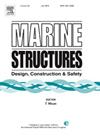含氯腐蚀的圆形高强自密实钢管混凝土轴压特性研究
IF 4
2区 工程技术
Q1 ENGINEERING, CIVIL
引用次数: 0
摘要
钢管混凝土在海洋环境中被广泛用作桥墩,其外层钢管极易受到氯化物腐蚀,从而降低结构构件的承载能力。本文对高强自密实钢管混凝土(HSSCCFST)受氯化物腐蚀的轴压特性进行了试验研究。该研究旨在确定钢比和腐蚀速率对钢板和HSSCCFST柱在氯化物腐蚀下的行为的影响。分析了其破坏模式、荷载-位移曲线、荷载-应变关系、承载力、刚度、延性、约束效应系数、强度指标和强度折减系数。结果表明:钢片壁厚越厚,钢片的正常断裂越多,钢片的力学性能随腐蚀速率的增加而降低;随着腐蚀速率的增加,HSSCCFST的轴压刚度、延性和残余极限强度因子均减小,但氯腐蚀的影响随钢比的增加而减小。腐蚀速率的增加削弱了钢管与混凝土芯间的复合作用。提出了考虑腐蚀速率和钢比的极限强度折减系数简化公式,并推荐使用CECS 104-99来预测氯化物腐蚀影响下HSSCCFST短柱的极限强度。本文章由计算机程序翻译,如有差异,请以英文原文为准。
Axial compression behavior of circular high-strength self-compacting concrete-filled steel tubes with chloride corrosion
Concrete-filled steel tubes (CFSTs) are widely used as bridge piers in marine environments, where the outer steel tubes are highly susceptible to chloride corrosion, which degrades the carrying capacity of structural elements. This paper presents an experimental investigation on the axial compressive behavior of high-strength self-compacting concrete-filled steel tubes (HSSCCFST) with chloride corrosion. The study aims to determine the effects of steel ratio and corrosion rate on the behavior of steel plate and HSSCCFST columns subjected to chloride corrosion. The failure modes, load-displacement curves, load-strain relationship, carrying capacity, stiffness, ductility, confinement effect coefficient, strength index, and strength reduction factor are analyzed. The results show that the thicker the wall thickness of steel coupon, the more normal fracture occurs in the steel tensile coupons, the mechanical properties of steel coupons decrease as the corrosion rate increases. The axial compressive stiffness, ductility, residual ultimate strength factor of HSSCCFST decrease with the increase of corrosion rate, however, the impact of chloride corrosion deceases with the increase of steel ratio. Besides, the increase in corrosion rate weakens the composite action between the steel tube and the concrete core. A simplified formula of ultimate strength reduction factor considering corrosion rate and steel ratio is proposed, and CECS 104–99 is recommended to predict the ultimate strength of HSSCCFST stub column affected by chloride corrosion.
求助全文
通过发布文献求助,成功后即可免费获取论文全文。
去求助
来源期刊

Marine Structures
工程技术-工程:海洋
CiteScore
8.70
自引率
7.70%
发文量
157
审稿时长
6.4 months
期刊介绍:
This journal aims to provide a medium for presentation and discussion of the latest developments in research, design, fabrication and in-service experience relating to marine structures, i.e., all structures of steel, concrete, light alloy or composite construction having an interface with the sea, including ships, fixed and mobile offshore platforms, submarine and submersibles, pipelines, subsea systems for shallow and deep ocean operations and coastal structures such as piers.
 求助内容:
求助内容: 应助结果提醒方式:
应助结果提醒方式:


